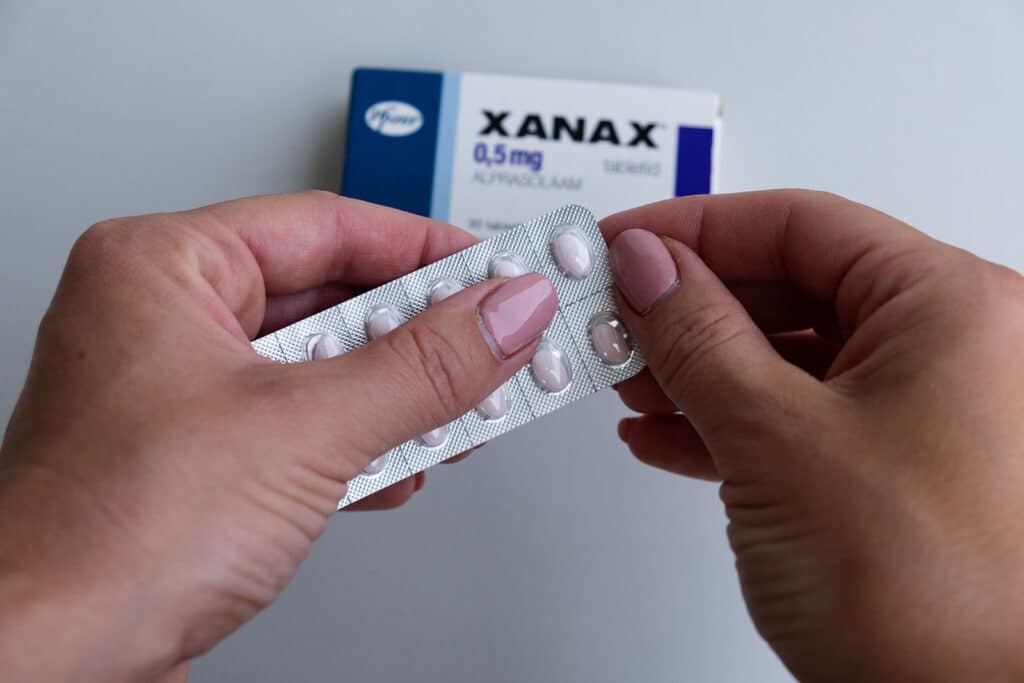Alprazolam, commonly known by its brand name Xanax, is a fast-acting, benzodiazepine medication. Medical professionals will prescribe alprazolam (Xanax) to treat anxiety disorders, whether it’s generalized anxiety or a panic disorder.
Since Xanax belongs to the popular drug class benzos, it works by increasing the activity of a certain neurotransmitter, namely GABA (or gamma-aminobutyric acid). The result? A calming effect washes over the individual, relaxing them and putting them at ease.

And so, because of Xanax’s fast-releasing nature and immediate effect, it becomes rather easy to misuse or abuse this drug. Abrupt discontinuation of the drug will also result in serious side effects, some of which are life-threatening.
If you, or your loved one, are dealing with a Xanax addiction, read on to better understand its symptoms. You’ll learn of valid treatment options as well, and how we at Illinois Recovery Center can support you through your recovery journey.
Table of Contents
- What Does a Xanax Addiction Look Like?
- How to Know if a Loved One is Addicted to or Dependent on Xanax
- How Common is Xanax Addiction in Illinois?
- What Treatment Options Are Available for Xanax Addiction?
- Recovery is Promised at the Illinois Recovery Center
What Does a Xanax Addiction Look Like?
The first step to full recovery includes learning what a Xanax addiction looks like. How does it manifest itself? What are the warning signs? These are the questions we answer in this section.
Behavioral Changes
Xanax addiction can lead to mood swings, irritability, and erratic behavior. You’ll find that users may become more agitated and hostile—especially when they can’t access the drug.
That brings us to our next behavioral change. Those suffering from a Xanax addiction will spend much time obsessing over their next dose. They’ll prioritize obtaining Xanax over their personal responsibilities.
They may neglect those responsibilities entirely – whether it includes their job, family, school, or home. With this addiction, it becomes harder for users to meet deadlines, attend important events, or appropriately perform their roles.
Psychological Changes
Believe it or not, long-term misuse of Xanax can lead to rebound anxiety whenever the drug wears off. Indeed, it’s quite ironic.
Individuals end up feeling more anxious than they did before they started taking the drug. This hellish loop leads to a never-ending addiction cycle to manage this new heightened level of anxiety.
Worse, if the individual suffers from an underlying mental health condition (such as depression or bipolar disorder), a Xanax addiction will aggravate the symptoms associated with these issues. It may eventually lead to suicidal ideation or behavior.
A Xanax addiction can also impair cognitive function. Signs may include memory problems, constant confusion, and impaired decision-making abilities. In severe cases, chronic Xanax abuse can induce psychosis. It manifests as hallucinations, delusions, and impaired insight into reality.
Physical Changes
Xanax is a central nervous system depressant. As such, one of the most noticeable physical effects is sedation and drowsiness. While under its influence, individuals appear lethargic and sleepy.
Further, they’ll exhibit difficulty articulating words clearly or have a slowed rate of speech. The drug will also adversely affect motor skills and coordination, leading to frequent falling accidents.
More seriously, Xanax abuse can affect heart rate and blood pressure, leading to fluctuations in cardiovascular functions. Users experience palpitations, chest pain, or dizziness as a result.
In high doses, or when mixed with other substances (i.e. alcohol or opioids), Xanax causes respiratory depression. You can identify that by the person’s slowed, shallow breathing. It can be life-threatening and will need immediate medical attention.
Other common physical changes (side effects) a person suffering from a Xanax addiction include:
- Gastrointestinal disturbances: Those involve nausea, vomiting, constipation, or diarrhea.
- Weight changes: Due to changes in appetite and eating patterns associated with Xanax use, some individuals may experience weight fluctuations.
- Skin problems: Although it’s rare, some users are allergic to Xanax or sensitive to it. When they abuse it, the addiction leads to skin reactions, such as rashes, itching, or hives.

How to Know if a Loved One is Addicted to or Dependent on Xanax
The aforementioned warning signs aren’t enough to tell if a loved one is addicted to Xanax. What if they’re simply dependent on the drug? That’s an excellent question, and it’s one this section aims to help you with.
Dependency or Addiction: Which is It?
Being dependent on a drug means you can’t function without it. Abruptly stopping it would cause serious withdrawal symptoms. Such symptoms can include:
- Sleep disturbances (insomnia, difficulty staying asleep, fatigue, and irritability)
- Shaking or tremors, particularly in the hands. They can be mild or moderate in intensity.
- Muscle aches, pains, or stiffness
- Sensitivity to light or sound, accompanied by headaches and migraines
- Gastrointestinal distress (e.g. nausea, diarrhea, abdominal cramps…etc.)
- Excessive sweating, particularly night sweats
- Heart palpitations, lightheadedness, and blood pressure fluctuations
Alternatively, withdrawal, or detox, for a person battling a Xanax addiction is way rougher. In their case, addiction is more serious than simply being reliant on the drug. For them, Xanax takes over their lives and becomes a problem that needs intervention.
With a Xanax addiction, individuals find it hard to focus when the drug wears off (Xanax has a short half-life. It stays in the body for approx. 11-12 hours). They continue to abuse the drug despite the negative consequences, whether they’re financial, psychological, or social.
How Common is Xanax Addiction in Illinois?
Xanax is readily prescribed by US doctors. A 2021 study showed that an estimated 15.4 million Xanax prescriptions are written every year. That number makes Xanax one of the most commonly prescribed benzodiazepines for anxiety disorders.
Such widespread availability makes it easy to misuse the drug. Xanax abuse is more prevalent in young adults, for instance, those between the ages of 18 and 29. Approximately 12.5% of the US use benzos like Xanax, with around 2.1% of that bracket abusing the drugs.
While those numbers don’t pertain to Illinois specifically, they should still alarm you—especially if you or a loved one fall under the demographic above. You’re more vulnerable to a Xanax addiction due to various factors, such as peer pressure, stress, and unresolved mental health issues.

What Treatment Options Are Available for Xanax Addiction?
A Xanax addiction seems like a monster when you or a loved one is struggling with it, but it doesn’t make it undefeatable.
In this section, you’ll find the treatment options you can choose from to help you better manage a Xanax addiction; to end it once and for all.
Inpatient Treatment Programs
Inpatient treatment programs, also known as residential rehabilitation programs, offer intensive and structured care for those struggling with addiction.
One of their key features is 24/7 supervision and support. Inpatient programs provide round-the-clock medical supervision. Addiction specialists ensure the patient’s safety and provide immediate assistance when withdrawal complications occur.
What Does an Inpatient Treatment Program Typically Include?
Residential programs follow a structured daily schedule. Each day can include therapy sessions, educational workshops, recreational activities, and time for self-reflection.
Peer support is another big part of inpatient care. Opportunities, such as group therapy sessions and support groups, help foster a sense of community among participants.
There will be therapeutic interventions as well. Their purpose is to address underlying issues that directly contribute to addiction, to then help develop coping strategies for relapse prevention. Examples include cognitive behavioral therapy (CBT) and trauma-informed therapy.
Who is Inpatient Care for?
Inpatient care involves tailoring treatment plans to meet the unique needs of an individual trying to battle their Xanax addiction.
If you feel you or a loved one will respond to a combination of individual therapy, group therapy, behavioral interventions, and holistic approaches, then inpatient treatment is the ideal choice.
Keep in mind: Inpatient programs often ask for family therapy sessions or workshops. These help address family dynamics and communication patterns. It’s an important step in long-term recovery as well.
How Long Does an Inpatient Program Last?
The duration of an inpatient program varies. It’ll depend on individual needs and the recovery progress. Some programs last for 30 days, others extend to 60, and sometimes, 90 days.

Outpatient Treatment Programs
Outpatient treatment programs are far less extensive than inpatient ones. While still offering comprehensive care, they offer more flexibility.
What Does an Outpatient Treatment Program Typically Include?
Under an outpatient program, individuals attend therapy sessions and other treatment activities while still living at home.
Other than that, outpatient care offers the same personalized touch as inpatient care. Treatment plans are also tailored to each individual, and can include all or a combination of the following:
- Individual therapy sessions with licensed counselors
- Group therapy to develop coping skills
- Medication-assisted treatment (MAT) for Xanax addiction
- Psychoeducational workshops that educate patients on addiction, recovery principles, coping strategies, and healthy lifestyle habits
Who is Outpatient Care for?
Outpatient programs are ideal for those who don’t wish to disrupt their daily lives while they address their Xanax addiction. It’s also an ideal choice for people who don’t struggle with a severe addiction to the drug and won’t require a medical detox or 24/7 supervision.
How Long Does an Outpatient Program Last?
For the most part, an individual’s progress is monitored before a medical professional judges how long the program should last. That said, you can expect outpatient care to last from 3 months to a year.

Recovery is Promised at the Illinois Recovery Center
There’s hope. At the Illinois Recovery Center, we offer the necessary treatment programs to appropriately handle a Xanax addiction.
For instance, we understand that detoxing from benzodiazepines can be a stressful process. We make sure that our trained staff carefully monitors the struggling individuals and grants them the help needed to push through to the next step.
After detox, individuals can pick which of our treatment programs suits them best. Contact us today to learn more about any of the following programs:
- Residential Treatment
- Partial Hospitalization program
- Intensive Outpatient Program (IOP)
- Outpatient Treatment Program
It doesn’t stop there. At Illinois Recovery Center, we also offer patients multiple ongoing aftercare options. There’s the Sober Living program, for example. Our trained staff can also put together a Relapse Prevention Plan for patients.
Please contact Illinois Recovery Center to learn about Xanax Addiction Treatment near you.



